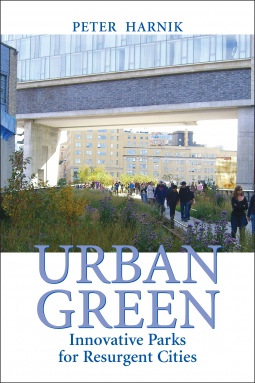
Urban Green
Innovative Parks for Resurgent Cities
by Peter Harnik
This title was previously available on NetGalley and is now archived.
Send NetGalley books directly to your Kindle or Kindle app
1
To read on a Kindle or Kindle app, please add kindle@netgalley.com as an approved email address to receive files in your Amazon account. Click here for step-by-step instructions.
2
Also find your Kindle email address within your Amazon account, and enter it here.
Pub Date Jun 08 2010 | Archive Date Mar 08 2022
Description
About Urban Green:
For years American urban parks fell into decay due to disinvestment, but as cities began to rebound—and evidence of the economic, cultural, and health benefits of parks grew— investment in urban parks swelled. The U.S. Conference of Mayors recently cited meeting the growing demand for parks and open space as one of the biggest challenges for urban leaders today. It is now widely agreed that the U.S. needs an ambitious and creative plan to increase urban parklands.
Urban Green explores new and innovative ways for “built out” cities to add much-needed parks. Peter Harnik first explores the question of why urban parkland is needed and then looks at ways to determine how much is possible and where park investment should go. When presenting the ideas and examples for parkland, he also recommends political practices that help create parks.
The book offers many practical solutions, from reusing the land under defunct factories to sharing schoolyards, from building trails on abandoned tracks to planting community gardens, from decking parks over highways to allowing more activities in cemeteries, from eliminating parking lots to uncovering buried streams, and more. No strategy alone is perfect, and each has its own set of realities. But collectively they suggest a path toward making modern cities more beautiful, more sociable, more fun, more ecologically sound, and more successful.
About Peter Harnik:
Peter Harnik is director of the Center for City Park Excellence at the Trust for Public Land and author of Inside City Parks, a book about the park and recreation systems of the 25 largest U.S. cities. In 2003, his research resulted in The Excellent City Park System: What Makes it Great and How to Get There. Previous to that, he was co-founder of the Rails-to-Trails Conservancy.
Table of Contents:
Acknowledgements
Introduction
Part I. Of Cities and Parks
Chapter 1: How Much Parkland Should a City Have?
Chapter 2: The Different Kinds of Parks and Their Uses
Box 2.1 What People do in Parks
Chapter 3: Is it Acres, Facilities or Distance?
Box 3.1 How Far to a Park?: 14 Scenarios
Chapter 4: Parks and Their Competition
Chapter 5: Neighborhoods Are Not All Created Equal
Chapter 6: It's Not How Much but Who and Why?
Chapter 7: A Process Rather than a Standard
Chapter 8: Stop, Look and Listen
Chapter 9: Analyze and Prioritize
Chapter 10: Money and Time
Part II. Finding Park Space in the City
Chapter 11: Buying it
Chapter 12: Utilizing Urban Redevelopment
Chapter 13: Community Gardens
Chapter 14: Old Landfills
Chapter 15: Wetlands and Stormwater Storage Ponds
Chapter 16: Rail-Trails
Chapter 17: Rooftops
Chapter 18: Sharing Schoolyards
Chapter 19: Covering Reservoirs
Chapter 20: River and Stream Corridors
Chapter 21: Cemeteries
Chapter 22: Boulevards and Parkways
Chapter 23: Decking Highways
Chapter 24: Closing Streets and Roads
Chapter 25: Removing Parking
Chapter 26: Increasing Time
Conclusion
Available Editions
| EDITION | Paperback |
| ISBN | 9781597266796 |
| PRICE | $30.00 (USD) |
| PAGES | 185 |



